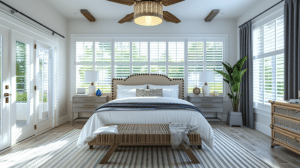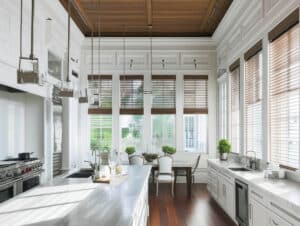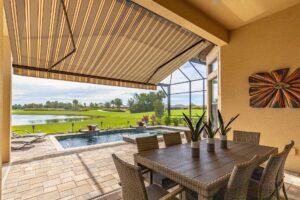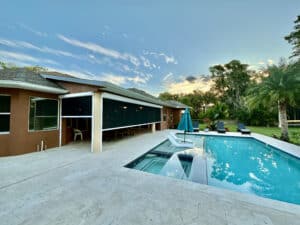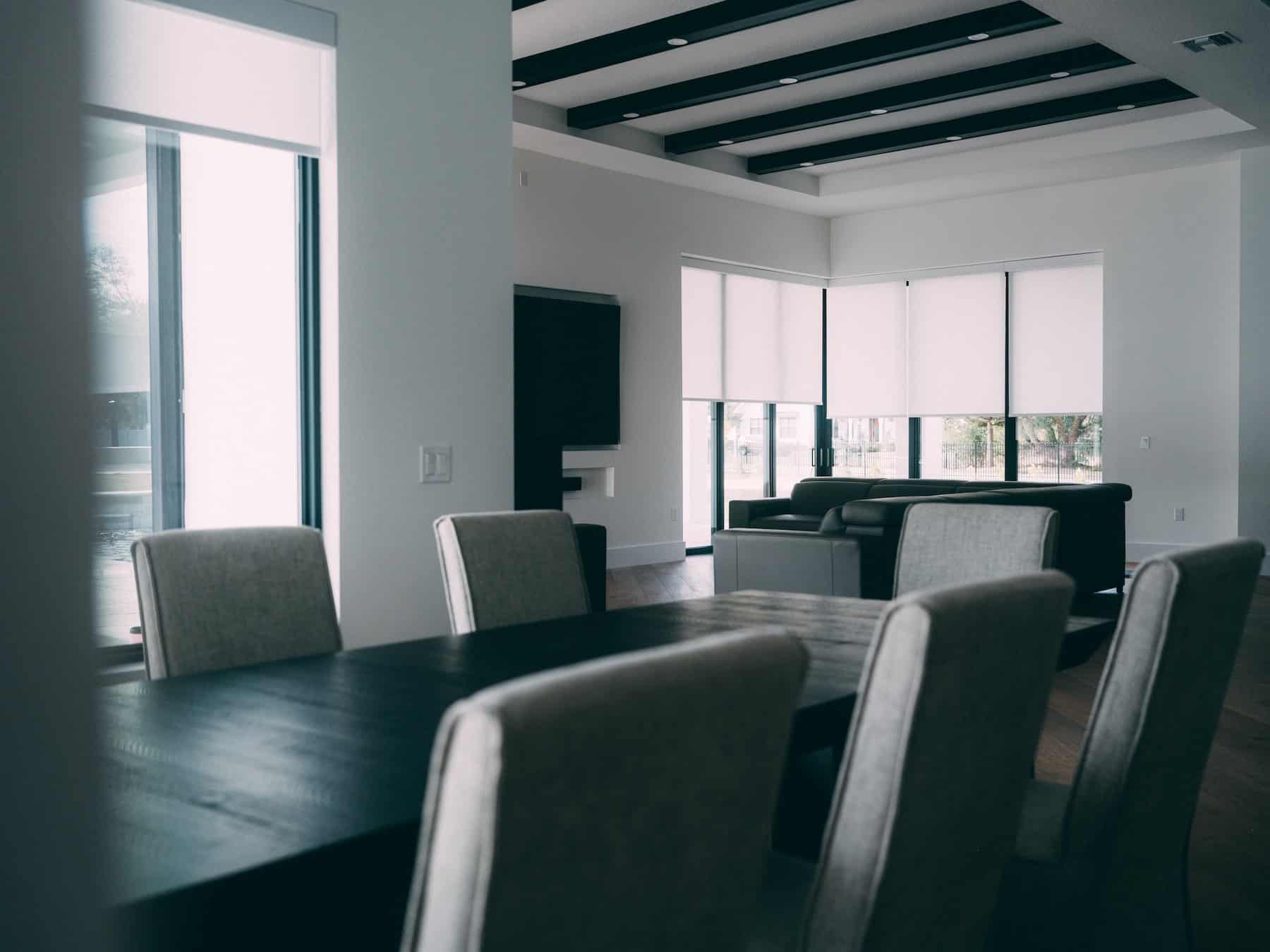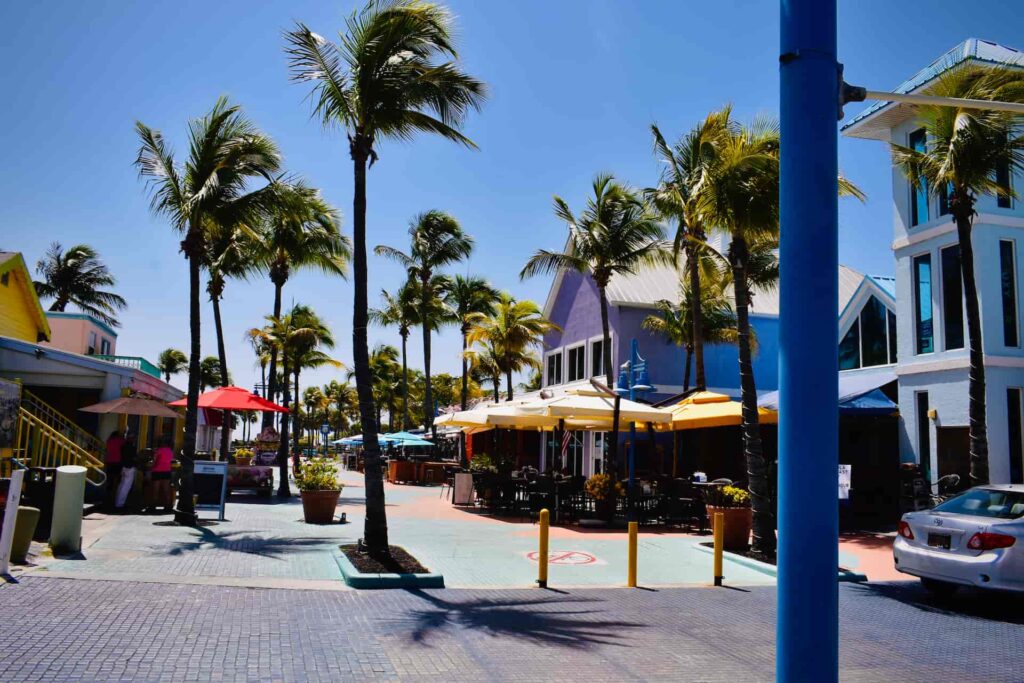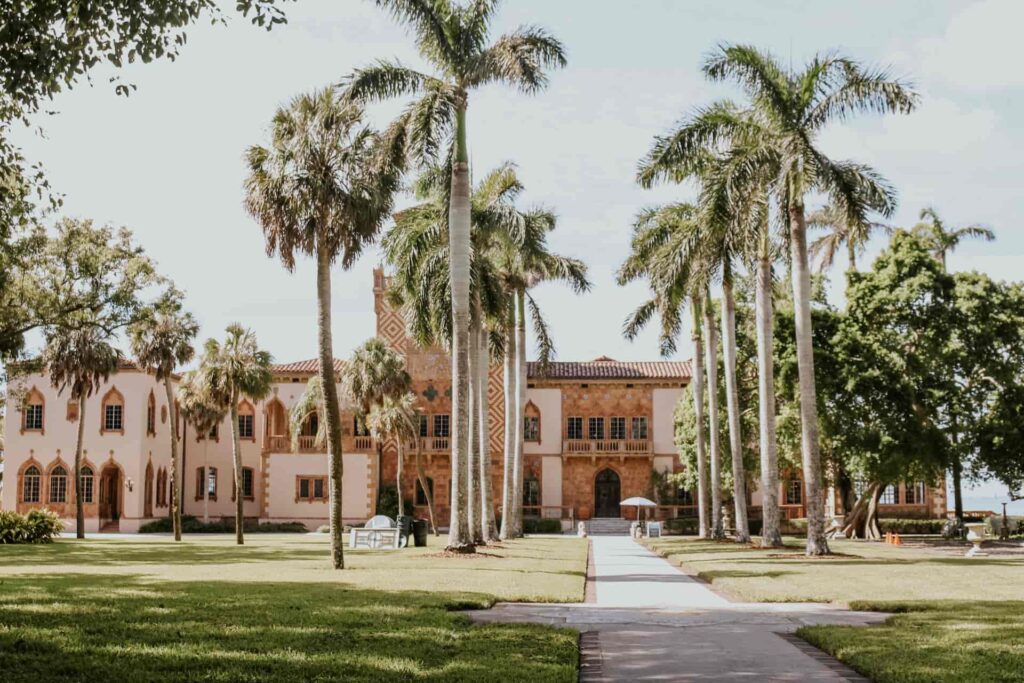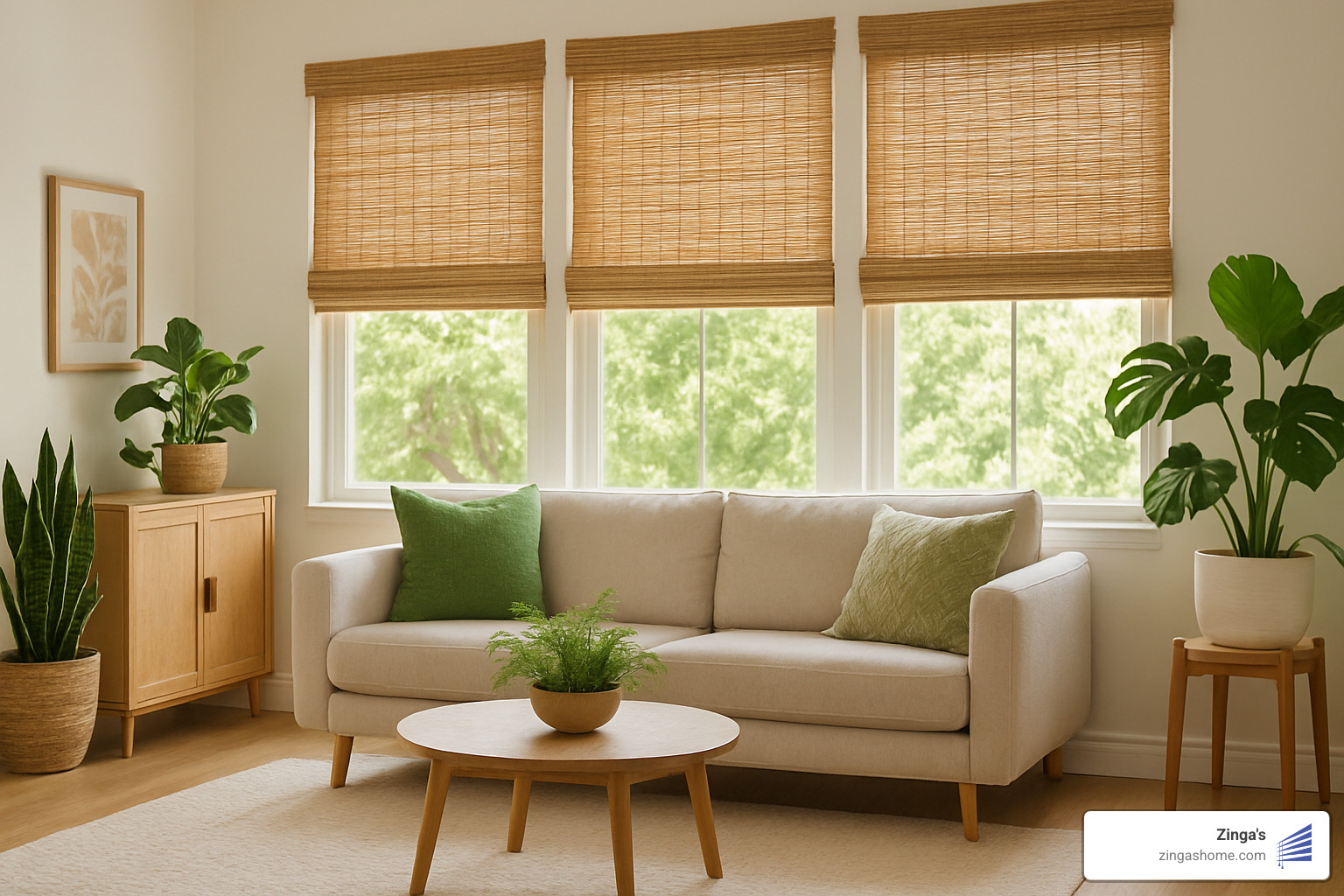
Green Your Scene with These Eco Friendly Window Blinds
May 22, 2025
Buy 1 Get 1 50% OFF
Everything*
$750 OFF 1st Screen
$500 OFF 2nd Screen
Request Free
In-Home Consultation
Transform Your Home with Sustainable Window Treatments
Eco friendly window blinds are window coverings made from sustainable materials like bamboo, hemp, or recycled content that reduce environmental impact while improving energy efficiency. Here's what makes them special:
- Materials: Made from bamboo, jute, recycled aluminum, or PVC-free fabrics
- Energy savings: Can reduce monthly power bills by up to 30%
- Air quality: Many are GREENGUARD certified for low emissions
- Insulation: Cellular shades can reduce summer heat gain by up to 45%
- Lifespan: Designed for durability with recyclable components
The growing focus on sustainable living has transformed how we think about home décor. As heating and cooling costs continue to rise, homeowners are finding that the right window treatments can make a significant difference in both comfort and utility bills.
Today's eco-friendly blinds do more than just look good – they're designed with the planet in mind from production to installation. Unlike conventional window coverings that might contain volatile organic compounds (VOCs) or non-recyclable materials, sustainable options prioritize renewable resources and energy efficiency.
Whether you're renovating your entire home or simply updating a room, choosing environmentally conscious window treatments is a small change that delivers big benefits for both your living space and the planet.
I'm George Huizinga, founder of Zinga's, and I've spent over a decade helping homeowners find the perfect eco friendly window blinds that balance sustainability with style and functionality, ensuring each solution improves both your home's comfort and environmental footprint.
Why Choose Eco Friendly Window Blinds?
When you're making your home more environmentally friendly, window treatments might not be the first thing that comes to mind. But let me tell you – eco friendly window blinds are actually one of the smartest green upgrades you can make. They're not just better for the planet; they'll transform how your home feels and performs year-round.
I've seen how the right window treatments can turn a stuffy, uncomfortable room into a perfectly balanced sanctuary. The secret is in the insulation properties these sustainable blinds provide. By creating a thermal barrier between your cozy living space and the sometimes harsh outdoors, they maintain consistent temperatures regardless of what Mother Nature is doing outside your windows.
This isn't just about comfort – it's about real savings too. Our customers are consistently amazed when they see their energy bills drop by up to 30% after installation. That's money back in your pocket every single month while simultaneously reducing your carbon footprint. It's one of those rare win-wins where doing the right thing for the environment also benefits you directly.
What Makes Eco Friendly Window Blinds Different?
So what exactly sets sustainable blinds apart from conventional options? It starts with thoughtful material choices. True eco friendly window blinds use renewable resources like bamboo, which can grow up to three feet in a single day, or jute and hemp fibers that require minimal water and no pesticides.
Many of our products incorporate recycled content too, giving new life to materials that would otherwise end up in landfills. I'm particularly proud of our hardwood options that come from sustainable-yield forestry. It's amazing to think that North American forests actually have 90% more hardwood trees today than 50 years ago, thanks to responsible management practices like these.
The manufacturing process matters just as much as the materials. The best eco-conscious producers use closed-loop water systems that minimize waste, recycle all metal and fabric scraps, and source materials locally to reduce transportation emissions. Even the packaging is thoughtfully designed – our products arrive with minimal wrapping that contains at least 44% post-consumer recycled content.
Unlike conventional blinds that might contain potentially harmful chemicals, our eco friendly window blinds are typically PVC-free and made without toxic flame retardants or unnecessary additives. We believe your window treatments shouldn't compromise your indoor air quality or the environment.
The best part? When these blinds eventually reach the end of their (very long) life, many can be recycled, composted, or repurposed. It's about thinking through the entire lifecycle of the product, not just how it looks in your window today.
How Eco Friendly Window Blinds Improve Indoor Air Quality
One benefit people often overlook is how much sustainable window treatments can improve the air you breathe every day. Many conventional blinds contain volatile organic compounds (VOCs) that can release into your home for years, potentially causing headaches, respiratory irritation, and other health issues.
In contrast, many of our eco friendly window blinds carry the GREENGUARD Indoor Air Quality Certification. This isn't just marketing fluff – it means they've been rigorously tested in independent labs to ensure they meet strict chemical emission limits. When I recommend these products to families, especially those with young children or allergies, I know I'm helping create a healthier home environment.
Beyond chemical emissions, these blinds serve another important health function – UV protection. According to scientific research, harmful UV radiation can damage your skin even through windows. The right window coverings significantly reduce this exposure, protecting not only your family but also preventing your furniture, artwork, and flooring from fading and deterioration.
At Zinga's, we take indoor air quality seriously when recommending products. I've worked with customers who noticed immediate improvements in their allergies and overall comfort after switching to more sustainable window treatments. It's these kinds of real-life benefits that make me passionate about helping homeowners make smarter choices for their living spaces.
1. Cellular (Honeycomb) Shades
If you're serious about energy efficiency in your home, cellular shades are the superstars of the eco friendly window blinds world. I've seen countless homeowners amazed at the difference these innovative treatments make, both in comfort and on their utility bills.
What makes these shades special is their distinctive honeycomb structure that creates air pockets between your windows and living space. This clever design wasn't an accident – cellular shades were actually the first window covering specifically engineered with insulation as the primary goal, and they continue to outperform other options for energy efficiency.
The science behind their effectiveness is impressive. These shades provide an R-Value rating between 1 and 5 (with double-cell varieties at the higher end), which means they create a substantial thermal barrier. When installed properly, they can reduce summer heat gain by up to 45% when placed close to glass. During winter, they work just as hard to keep warm air from escaping through your windows.
You'll find cellular shades in various configurations to match your needs – single-cell for standard insulation, double-cell for improved performance, and even triple-cell for maximum thermal protection. For rooms where you want both energy efficiency and complete darkness, blackout cellular shades block up to 99% of outside light while providing superior insulation.
Why They're Green
The environmental benefits of cellular shades go well beyond just saving energy. Many of today's options are manufactured with sustainability in mind, using recyclable polyester materials that contain no PVC and contribute to LEED Certification points for green building projects.
I'm particularly impressed by manufacturers who take a holistic approach to sustainability. The best cellular shade producers implement closed-loop water systems during manufacturing, recycle all waste materials, and ship their products with minimal packaging made from significant amounts of post-consumer recycled content.
At Zinga's, we're committed to partnering with these forward-thinking manufacturers. When we recommend cellular shades for your home, you can feel confident that your choice is as kind to the planet as it is to your energy bills.
Performance & Cost
Let's talk real benefits – homeowners who install cellular shades throughout their homes typically see power bill reductions of up to 30%, with the biggest savings coming during extreme weather seasons. This isn't just marketing hype; it's what our customers consistently report back to us.
In terms of investment, cellular shades fall into the mid-to-premium price range. Basic options start around $50 per window, while premium features like double-cell construction, designer fabrics, or motorization can bring the cost to $150-$400+ per window. Yes, that's more than some alternatives, but the long-term energy savings and exceptional durability make them a smart economic choice over time.
What I love most about cellular shades is their year-round performance. In winter, they trap precious heat inside your home, easing the burden on your heating system. During summer, they block solar heat gain, keeping your rooms noticeably cooler and reducing air conditioning costs. This consistent performance in all seasons makes them an excellent investment regardless of your climate.
Eco Friendly Window Blinds in Action
One of my favorite customer stories comes from a Nashville family who installed double-cell blackout cellular shades in their north-facing primary bedroom. They'd been struggling with uncomfortable drafts during Tennessee winters, making the room feel chilly despite cranking up the heat.
After installation, the change was remarkable. The room maintained a much more consistent temperature, with the bone-chilling drafts virtually eliminated. Their winter heating bills decreased by approximately 22% compared to the previous year, despite similar weather conditions.
What they didn't expect was how much better they would sleep. The combination of more stable room temperature and improved light blocking created an ideal sleep environment. As they told me during our follow-up visit, "We should have done this years ago!"
This real-world example perfectly illustrates why eco friendly window blinds like cellular shades deliver benefits that go beyond environmental impact – they genuinely improve quality of life while reducing energy consumption.
Want to learn more about these remarkable window treatments? Check out our detailed cellular shades information page for additional specifications and options.
2. Bamboo & Woven Wood Shades
There's something magical about the way natural light filters through bamboo and woven wood shades, casting dappled patterns across your living space while bringing the warmth of nature indoors. These eco friendly window blinds have become increasingly popular among homeowners looking to infuse their interiors with organic textures while making environmentally responsible choices.
The sustainability story of bamboo is truly remarkable. As one of the planet's fastest-growing plants – with some species shooting up an astonishing 35 inches in a single day – bamboo reaches harvest maturity in just 3-5 years, compared to decades for traditional hardwoods. This rapid renewal makes bamboo an exceptionally sustainable choice for your windows.
Beyond bamboo, many of our woven shades incorporate other rapidly renewable materials like jute, reeds, and natural grasses. These materials bring unique textures and visual interest to your windows while supporting sustainable agricultural practices. What's even more appealing is that when these shades eventually reach the end of their lifespan, many are backyard-compostable, returning naturally to the earth rather than lingering in landfills.
Sustainability Highlights
The environmental benefits of these shades begin at the source. The sustained-yield forestry practices used to harvest materials ensure that removal rates remain well below natural growth, preserving these precious resources for generations to come. This responsible management has contributed to significant increases in forest volume across North America over recent decades.
Many of our premium woven wood offerings skip harsh chemical treatments altogether. By avoiding unnecessary dyes and finishes, manufacturers preserve the authentic beauty of natural materials while eliminating potentially harmful substances from your home. This approach results in window treatments that are not only visually stunning but also safer for your family and gentler on the planet.
I've personally seen how these natural window treatments transform spaces in ways synthetic options simply can't match. There's an inherent warmth and character to bamboo and woven woods that creates a grounded, peaceful atmosphere in any room they grace.
Styles & Customization
The versatility of woven wood shades means you're never limited to a one-size-fits-all solution. Roman-style shades create neat, neat horizontal folds when raised, offering a custom look that works beautifully in more formal spaces. For a more relaxed vibe, waterfall designs drape with casual sophistication, perfect for creating that laid-back coastal or bohemian feel many homeowners crave.
Privacy concerns? Not a problem. Many of our clients choose to add privacy or blackout liners that improve light control and insulation without sacrificing the natural aesthetic they love. Decorative edge banding in complementary colors adds a finished, custom touch that lifts the entire look.
Modern safety and convenience features have made these traditional materials more functional than ever. Cordless lift mechanisms provide a cleaner appearance while making your home safer for children and pets. For the ultimate in convenience, consider motorized options that integrate seamlessly with your smart home system, allowing adjustment with a simple voice command or smartphone tap.
At Zinga's, we take pride in offering an extensive selection of woven wood shades in various materials, weaves, and customization options. During your in-home consultation, our design experts will help you steer these choices to find the perfect balance of beauty, functionality, and sustainability for your unique space.
3. Solar (Screen) Shades
When it comes to balancing natural light, energy efficiency, and maintaining your view, solar shades stand out as true innovation stars in eco friendly window blinds. I've seen countless homeowners fall in love with these specialized treatments after experiencing how they transform sun-drenched rooms into comfortable, glare-free spaces.
Solar shades feature a technical mesh fabric available in various "openness factors" – essentially how tightly the material is woven. A 1% openness provides maximum privacy and UV protection, allowing just a tiny fraction of light through, while a 14% openness maintains excellent outward visibility while still filtering harsh sunlight. This versatility lets you customize the perfect balance for each room in your home.
What truly makes these shades remarkable is their ability to block up to 90% of harmful UV rays. This protection isn't just about preventing your furniture and flooring from fading – it's about your family's health too. According to scientific research, UV exposure through windows can contribute to skin damage over time, making solar shades a smart preventative measure.
Eco Benefits
The environmental impact of solar shades goes well beyond their materials. By strategically managing sunlight, these shades create what designers call the "daylighting effect" – maximizing natural illumination while minimizing heat gain. This means less reliance on both artificial lighting and air conditioning, creating a double energy-saving benefit that reduces your carbon footprint.
Many of our clients are surprised to learn that premium solar shades are manufactured using recyclable, PVC-free fabrics that contribute to LEED certification points in green building projects. When you choose these materials, you're making a choice that aligns with sustainable building practices from production through the entire product lifecycle.
I've worked with homeowners who've seen their summer cooling costs drop by 15-20% after installing solar shades on south-facing windows. The beauty is that these savings come without sacrificing the connection to the outdoors that makes windows so important to our wellbeing.
Where They Shine
Solar shades truly prove their worth in specific situations. South-facing windows that receive direct sunlight throughout the day become dramatically more comfortable with these shades installed. The harsh glare disappears, but the room remains bright and welcoming.
Home offices have become a solar shade sweet spot, especially as more people work from home. The ability to control screen glare while maintaining natural light creates an ideal productive environment without the eyestrain that comes from direct sunlight on monitors and devices.
For homes with spectacular views, solar shades offer something no other window treatment can – protection without obstruction. Unlike traditional blinds or drapes that block your vista when closed, solar shades maintain that visual connection to the outdoors while still providing energy benefits.
At Zinga's, we take the time to understand exactly how you use each room before recommending the perfect openness factor for your solar shades. A south-facing living room might benefit from a tighter 3% weave, while a north-facing bedroom might be perfect with a more open 10% fabric. This personalized approach ensures you get the ideal balance of light control, view preservation, and energy efficiency for your specific needs.
4. Recycled Faux Wood Blinds
Looking for the timeless appeal of wood blinds but need something more practical and planet-friendly? Recycled faux wood blinds might be your perfect match. These innovative eco friendly window blinds beautifully mimic the warm, natural appearance of real wood while offering remarkable durability in challenging environments.
What makes these blinds special is their thoughtful construction. Crafted from specially formulated composite materials with significant recycled content, they deliver the aesthetic charm of natural wood without the drawbacks. Their impressive resistance to moisture, warping, and fading makes them ideal for spaces where real wood might struggle – your steamy bathroom, busy kitchen, or humid laundry room won't pose any problems for these hardy blinds.
I've seen countless homeowners fall in love with the versatility of faux wood blinds. Their classic wood-grain appearance complements virtually any style, from cozy traditional to sleek contemporary. With a rainbow of colors and finishes available, you can either seamlessly blend them with existing décor or make them a standout design feature in your space.
Planet-Friendly Angle
The environmental story behind recycled faux wood blinds is genuinely impressive. By incorporating post-consumer PVC and other recycled plastics, these blinds give materials that might have ended up in landfills a valuable second life. This thoughtful approach not only reduces waste but also conserves the resources needed to produce new materials from scratch.
What I find particularly encouraging is that many faux wood blinds are themselves recyclable when they eventually reach the end of their useful life. This creates a more circular product lifecycle that significantly reduces long-term environmental impact. Their exceptional durability means they'll need replacing less frequently too – another environmental win.
Many of our customers appreciate that quality faux wood blinds are often produced domestically. Manufacturing closer to home means reduced transportation emissions and support for local economies. At Zinga's, we specifically seek out faux wood blinds made with these environmental considerations at heart.
Durability & Price
The remarkable durability of recycled faux wood blinds is perhaps their most compelling feature. Unlike natural wood, these resilient blinds won't crack, warp, or fade when exposed to moisture or direct sunlight. This exceptional longevity means less frequent replacements and lower lifetime environmental impact – what environmental experts call reduced "embodied carbon" (the total greenhouse gas emissions associated with a product throughout its life cycle).
From a budget perspective, faux wood blinds offer tremendous value. They're typically more wallet-friendly than real wood alternatives while providing similar aesthetics and superior performance in challenging environments. Most of our customers invest between $25 and $150 per window, depending on size and features – a reasonable price for blinds that will look beautiful for years to come.
I've worked with many homeowners who initially hesitated about choosing "faux" anything, worried it might look cheap or artificial. Their delight when seeing the finished installation never gets old – these blinds offer a perfect balance of beauty, performance, and environmental responsibility. For those wanting to make thoughtful choices for their home and the planet without sacrificing style, recycled faux wood blinds represent one of the most accessible and practical options in the eco friendly window blinds category.
5. Recycled Aluminum Mini Blinds
When it comes to eco-friendly window treatments that won't break the bank, recycled aluminum mini blinds shine bright. These sleek, versatile window coverings deliver impressive environmental benefits while remaining one of the most affordable options in the eco friendly window blinds market.
With their characteristic slim horizontal slats (typically 1" or less in width), aluminum mini blinds offer a clean, minimal profile that works beautifully in contemporary spaces. Despite their lightweight construction, quality aluminum blinds stand the test of time, providing reliable performance season after season without warping or fading.
What truly sets these blinds apart on the sustainability spectrum is their material composition. Premium aluminum blinds contain up to 95% recycled metal, giving new life to materials that might otherwise end up in landfills. This high recycled content dramatically reduces the environmental footprint compared to products made from virgin materials, while still delivering the crisp, clean look many homeowners desire.
Green Credentials
The environmental story of aluminum blinds extends well beyond their recycled content. Aluminum is 100% recyclable without any degradation in quality—meaning these blinds could potentially be recycled indefinitely. This remarkable closed-loop potential makes aluminum one of the most sustainable materials in the window treatment world.
The energy savings are equally impressive. Manufacturing recycled aluminum requires approximately 95% less energy than producing virgin aluminum, resulting in significantly lower carbon emissions. When you combine this energy efficiency with aluminum's exceptional durability, you get a window treatment with remarkably low environmental impact per year of use.
Even the packaging deserves mention in the sustainability conversation. Quality manufacturers now ship their aluminum blinds with minimal packaging that often incorporates significant post-consumer recycled content. This thoughtful approach reduces waste at every stage of the product lifecycle, further enhancing these blinds' eco-friendly credentials.
Best Use Cases
Recycled aluminum mini blinds particularly excel in several specific applications. Their budget-friendly price point makes them perfect for rental properties where cost constraints might otherwise limit sustainable options. Property managers can make environmentally responsible choices without excessive investment—a win for both the planet and the bottom line.
In busy households, these blinds' durability and easy maintenance become major advantages. Unlike fabric options that might trap dust or become stained, aluminum slats can be quickly wiped clean with a damp cloth. This practical benefit makes them ideal for kitchens, children's rooms, and other high-traffic areas where easy cleaning matters.
The slim profile of mini blinds makes them the perfect solution for windows with limited depth, where bulkier treatments simply wouldn't fit. They also work beautifully in layered window treatments, providing functional light control and privacy beneath decorative curtains or valances.
At Zinga's, we prioritize aluminum blinds that meet Consumer Product Safety Commission (CPSC) safety standards, ensuring these budget-friendly options don't compromise family safety. Our design consultants can help you determine whether these versatile, eco friendly window blinds might be the perfect match for your specific needs, bringing sustainable style to your home without stretching your budget.
6. Smart, Cordless & Motorized Upgrades
Remember when adjusting your blinds meant wrestling with tangled cords or getting up from your comfortable spot? Those days are rapidly becoming history thanks to the incredible advances in eco friendly window blinds technology. Today's smart features don't just add convenience—they're changing how our window treatments contribute to our home's comfort, safety, and energy efficiency.
Cordless lift systems have revolutionized how we interact with our blinds. Instead of dangling cords that collect dust and create hazards, you simply push up or pull down on the bottom rail to position your blinds exactly where you want them. The clean, streamlined look improves your décor while eliminating what safety experts have long identified as a serious risk in homes with young children or pets.
Motorization takes this convenience to new heights. Imagine adjusting all your blinds with the touch of a button—or better yet, having them adjust automatically based on the time of day or sunlight conditions. Modern motors are remarkably quiet and reliable, operating smoothly for years with minimal maintenance. Some systems even include solar sensors that track the sun's position, automatically adjusting your blinds throughout the day to optimize both comfort and energy efficiency.
The real magic happens when these motorized blinds connect to your smart home ecosystem. With voice command capability through popular platforms like Amazon Alexa or Google Assistant, you can simply ask your home to adjust the blinds while you're cooking, reading, or entertaining. These intelligent systems can even be programmed to work in concert with your other smart devices, creating seamless routines that improve both comfort and energy efficiency.
Why Upgrades Matter
The benefits of these advanced features go far beyond mere convenience. When your eco friendly window blinds automatically adjust to changing sunlight conditions, they become active participants in your home's energy management system. By optimizing solar heat gain in winter and minimizing it during summer, they can significantly reduce your heating and cooling costs while lowering your carbon footprint.
Safety concerns alone make these upgrades worth considering. According to the Consumer Product Safety Commission, window covering cords remain among the top five hidden hazards in American homes. Cordless and motorized options completely eliminate these risks, providing invaluable peace of mind for families.
There's also an important accessibility dimension to these upgrades. For seniors aging in place or individuals with mobility challenges, motorized window treatments can be truly life-changing. The ability to independently control light and privacy improves quality of life and supports greater autonomy. I've seen the difference this makes when helping customers with accessibility needs—the joy of regaining control over one's environment is powerful.
Compatibility
The good news is that most types of eco friendly window blinds can be equipped with smart features. Whether you're considering cellular shades, bamboo blinds, or aluminum mini blinds, there's likely a motorization option that will work beautifully with your choice.
Battery-powered motors offer the simplest installation path with no wiring required. Today's rechargeable lithium batteries can power your blinds for several months between charges, making maintenance practically effortless. For larger installations or frequently used blinds, hardwired motors provide consistent power without battery concerns, though they do require professional installation.
When selecting a smart blind system, it's worth considering how it will integrate with your existing home technology. Most leading brands offer compatibility with popular smart home platforms, but the specific features and integration capabilities can vary. At Zinga's, we take the time to understand your current setup and recommend solutions that will work seamlessly within your home ecosystem.
Already have blinds you love? You might not need to replace them entirely. Retrofit kits can add motorization to many existing window treatments, giving you modern convenience while extending the life of your current blinds—a win for both your wallet and the environment.
The benefits of motorization extend to virtually every aspect of your window treatments, from improved comfort and convenience to improved energy efficiency and safety. At Zinga's, we're passionate about helping you find the perfect balance of features to match your lifestyle, home, and budget. Our expert consultants can walk you through all the options and help you make informed choices that you'll enjoy for years to come.
Buying Guide & DIY Installation Tips
When it comes to selecting the perfect eco friendly window blinds for your home, there's a bit more to consider than just picking a pretty pattern or color. I've helped hundreds of homeowners steer these choices, and I've found that balancing sustainability, performance, and style is the key to long-term satisfaction.
| Blind Type | Average Price Range | R-Value | Best For |
|---|---|---|---|
| Cellular Shades | $50-$400 | 1-5 | Maximum insulation |
| Bamboo/Woven Wood | $60-$300 | 1-2.5 | Natural aesthetics |
| Solar Shades | $75-$350 | 0.8-4.7 | UV protection with views |
| Recycled Faux Wood | $25-$150 | 0.6-1.2 | Humid environments |
| Recycled Aluminum | $20-$100 | 0.5-0.9 | Budget-friendly options |
R-Value might sound technical, but it's simply a measure of insulation power – the higher the number, the better the blind will keep heat where you want it (inside during winter, outside during summer). Cellular shades lead the pack here, which explains why they're so effective at saving money on energy bills. But remember, your actual savings will depend on your local climate, which direction your windows face, and how well your windows are sealed.
When shopping for truly sustainable options, look beyond marketing claims. GREENGUARD certification offers genuine assurance of low chemical emissions, while specific details about recycled content percentages and material sourcing tell you how environmentally responsible the product really is.
Don't let budget constraints discourage you from making eco-friendly choices. Even our most affordable options like recycled aluminum blinds offer meaningful environmental benefits. And while cellular shades might cost more upfront, their energy-saving potential often means they pay for themselves over time – good for your wallet and the planet.
How to Measure for Eco Friendly Window Blinds
I can't stress enough how important accurate measurements are – even the most beautiful, sustainable blinds won't look or function properly if they don't fit your windows correctly. Here's my straightforward approach to getting it right:
First, grab a steel measuring tape – not a cloth tape or ruler, which can stretch or bend. For inside mount installations (where the blind fits inside the window frame), measure the exact window opening width at three points: top, middle, and bottom. Use the narrowest measurement to ensure your blinds will fit. Then measure the height at the left, center, and right, using the tallest measurement. Don't forget to check your window depth to make sure your chosen blinds will fit properly.
For outside mount installations (where blinds hang over the window frame), measure the width of the area you want to cover, adding at least 2 inches on each side for optimal light blockage. For height, add 3 inches at the top and 2 inches at the bottom to ensure complete coverage.
Always record your measurements as width × height, and be specific about which is which. Before finalizing your order, I recommend requesting free samples of your preferred materials – seeing and touching them in your actual space under different lighting conditions can prevent disappointment later.
Maintenance & End-of-Life
Taking care of your eco friendly window blinds doesn't have to be complicated. A regular dusting with a microfiber cloth or vacuum attachment prevents buildup that can affect both appearance and function. For spots and stains, a gentle wipe with mild, eco-friendly soap and water usually does the trick – skip the harsh chemicals that can damage finishes and release toxins into your home.
For deeper cleaning needs, consider professional services that specialize in window treatments, many of which now offer environmentally responsible cleaning methods.
Even the most sustainable products eventually reach the end of their useful life. When that time comes, consider these earth-friendly disposal options: donate still-usable blinds to organizations like Habitat for Humanity ReStore or local shelters; recycle through manufacturer take-back programs or local facilities that accept the specific materials; or compost natural fiber blinds made from bamboo or other plant materials (provided they don't contain synthetic components).
At Zinga's, we're committed to helping you make environmentally responsible choices throughout your window treatments' entire lifecycle. Our team can guide you through selection, installation, maintenance, and eventually, responsible replacement – just one more way we're working to make sustainable living more accessible for everyone.
Frequently Asked Questions about Eco Friendly Window Blinds
Are there rebates or incentives for installing energy-efficient blinds?
While federal tax credits typically focus on major energy improvements like windows and insulation, some local utilities and state programs offer rebates or incentives for energy-efficient window treatments. These programs vary by location and often change annually.
Energy-efficient window coverings may qualify as part of broader home energy improvement programs. We recommend checking with your local utility company and visiting the Database of State Incentives for Renewables & Efficiency (DSIRE) website to identify potential opportunities in your area.
Additionally, some manufacturers offer seasonal promotions or rebates on energy-efficient products. At Zinga's, we stay informed about these opportunities and can help you identify potential savings when you're ready to purchase.
What certifications should I look for (GREENGUARD, LEED, OEKO-TEX)?
Several key certifications indicate environmentally responsible window treatments:
GREENGUARD Certification ensures products meet strict chemical emissions limits, contributing to healthier indoor air quality. GREENGUARD Gold certification has even more stringent standards, making it ideal for sensitive environments like schools and healthcare facilities.
LEED Certification Friendly products contribute to points in the Leadership in Energy and Environmental Design (LEED) green building certification program. These products typically feature recycled content, sustainable sourcing, and low emissions.
OEKO-TEX Standard 100 certifies that textiles have been tested for harmful substances and are safe from a human-ecological perspective. This is particularly relevant for fabric shades and blinds.
Global Organic Textile Standard (GOTS) certifies that textiles contain a minimum of 70% organic fibers and meet environmental and social criteria along the entire supply chain.
When shopping for eco friendly window blinds, look for these certifications on product labels or manufacturer websites to verify environmental claims and ensure you're making a truly sustainable choice.
Can eco friendly blinds be recycled or composted at end of life?
The recyclability of window treatments depends on their materials and construction:
Aluminum blinds are fully recyclable through most municipal recycling programs. The high value of aluminum makes these blinds particularly attractive for recycling.
Cellular shades made from polyester can often be recycled where #1 plastic (PET) is accepted, though you may need to remove any cords or mechanisms first.
Bamboo and woven wood shades made from natural materials without synthetic components may be compostable in commercial composting facilities. Some can even decompose in backyard compost systems, though this process takes considerable time.
Faux wood blinds made from PVC or composite materials have more limited recycling options. Check with local waste management authorities for specific guidelines.
To maximize end-of-life options, some manufacturers offer take-back programs for their products. These programs ensure proper recycling or disposal through specialized channels not available to typical consumers.
At Zinga's, we can provide specific information about the recyclability of any window treatment we offer and guide you toward options that align with your end-of-life priorities.
Conclusion
Creating a more sustainable home doesn't mean sacrificing style, comfort, or functionality. Eco friendly window blinds offer that perfect sweet spot where environmental responsibility meets practical benefits—from noticeable energy savings to improved indoor air quality and improved living spaces.
Whether you're drawn to the exceptional insulation of cellular shades, the natural warmth of bamboo blinds, the smart UV protection of solar shades, or the long-lasting performance of recycled materials, each option represents a meaningful step toward reducing your environmental footprint while creating a more comfortable, beautiful home.
At Zinga's, we take genuine pride in being your partners on this journey toward sustainability. As a family-focused home design company with locations throughout Florida, Texas, Tennessee, and Indiana, we specialize in providing and installing customized shade solutions that work beautifully for both indoor and outdoor spaces. Our personalized in-home design consultations ensure you'll find window treatments that perfectly match your specific needs, style preferences, and environmental values.
Our commitment to sustainability isn't just about the products we offer. We approach every project with honesty and a genuine desire to improve your home in ways that benefit both your family and our shared planet. From your first conversation with us through professional installation and beyond, we're dedicated to providing exceptional service that creates lasting value.
The small changes you make in your window treatments can make a surprisingly big difference—in your comfort, your energy bills, and your environmental impact. When you're ready to transform your windows with sustainable, energy-efficient treatments, we're here to help make the process simple and enjoyable.
Ready to explore your options? Contact Zinga's today to schedule your free in-home consultation. Our friendly design experts will bring samples directly to your home, help you explore possibilities, and guide you toward the perfect eco friendly window blinds for your specific needs.
Take a moment to browse our complete selection of window blinds and other sustainable home solutions. Find how thoughtfully chosen window treatments can transform not just your windows, but your entire living experience—creating spaces that are more comfortable, more beautiful, and more in harmony with the world around us.

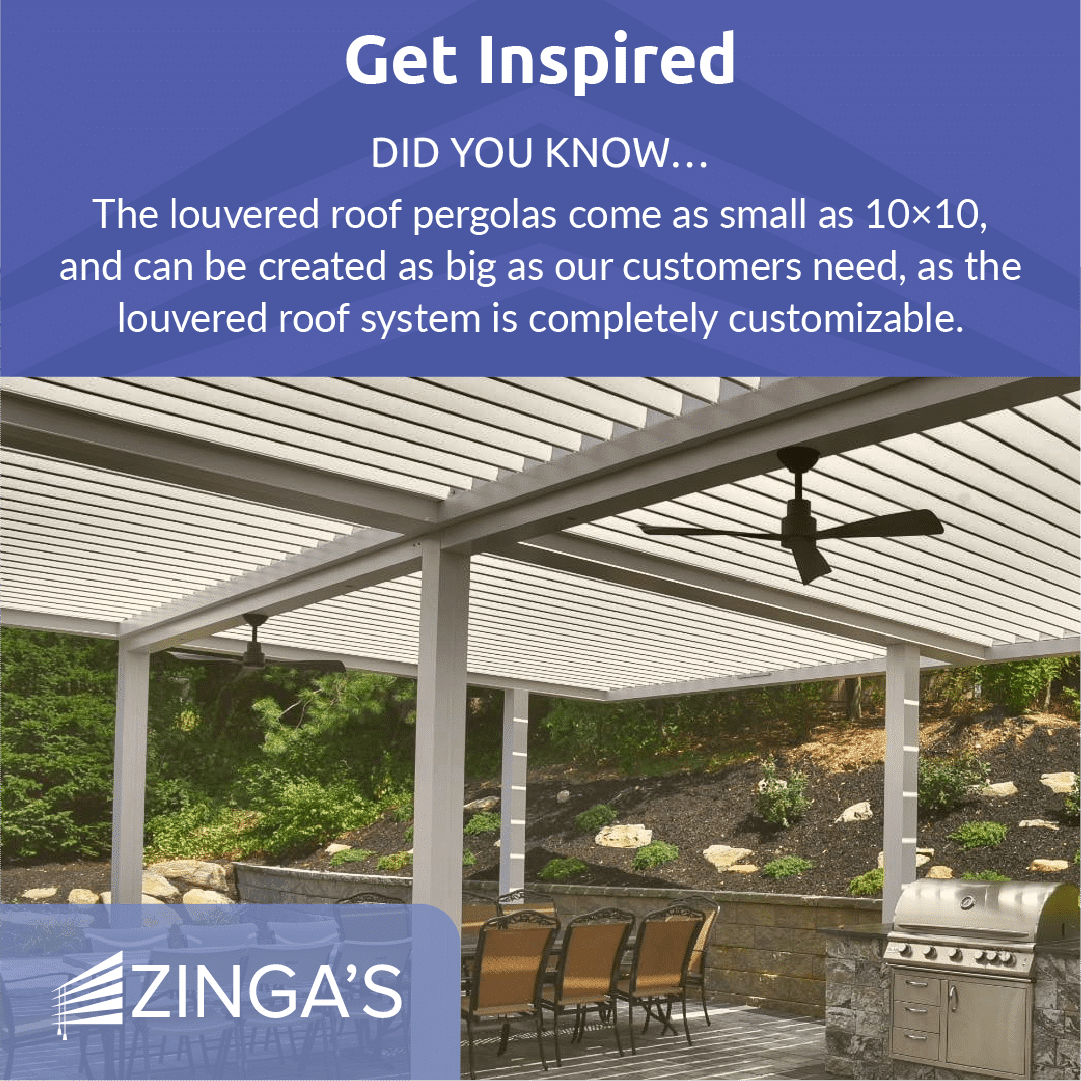
Recent Posts
Motorized Shades vs Manual Shades: Which Is Worth the Extra Cost?
Wood vs Composite Shutters in Humid Climates: Which Holds Up Better?
Why Your Motorized Blinds Stutter or Stall: Troubleshooting 5 Common Failures
Categories
Download our Motorized Pergola Guide
Looking for inspiration? Download our free feature packed pdf and see what all options you can get in your pergola.
Table of Contents
- Transform Your Home With Sustainable Window Treatments
- Why Choose Eco Friendly Window Blinds?
- What Makes Eco Friendly Window Blinds Different?
- How Eco Friendly Window Blinds Improve Indoor Air Quality
- 1. Cellular (honeycomb) Shades
- Why They're Green
- Performance & Cost
- Eco Friendly Window Blinds In Action
- 2. Bamboo & Woven Wood Shades
- Sustainability Highlights
- Styles & Customization
- 3. Solar (screen) Shades
- Eco Benefits
- Where They Shine
- 4. Recycled Faux Wood Blinds
- Planet-friendly Angle
- Durability & Price
- 5. Recycled Aluminum Mini Blinds
- Green Credentials
- Best Use Cases
- 6. Smart, Cordless & Motorized Upgrades
- Why Upgrades Matter
- Compatibility
- Buying Guide & Diy Installation Tips
- How To Measure For Eco Friendly Window Blinds
- Maintenance & End-of-life
- Frequently Asked Questions About Eco Friendly Window Blinds
- Are There Rebates Or Incentives For Installing Energy-efficient Blinds?
- What Certifications Should I Look For (greenguard, Leed, Oeko-tex)?
- Can Eco Friendly Blinds Be Recycled Or Composted At End Of Life?
- Conclusion
What Products Are You Interested In?
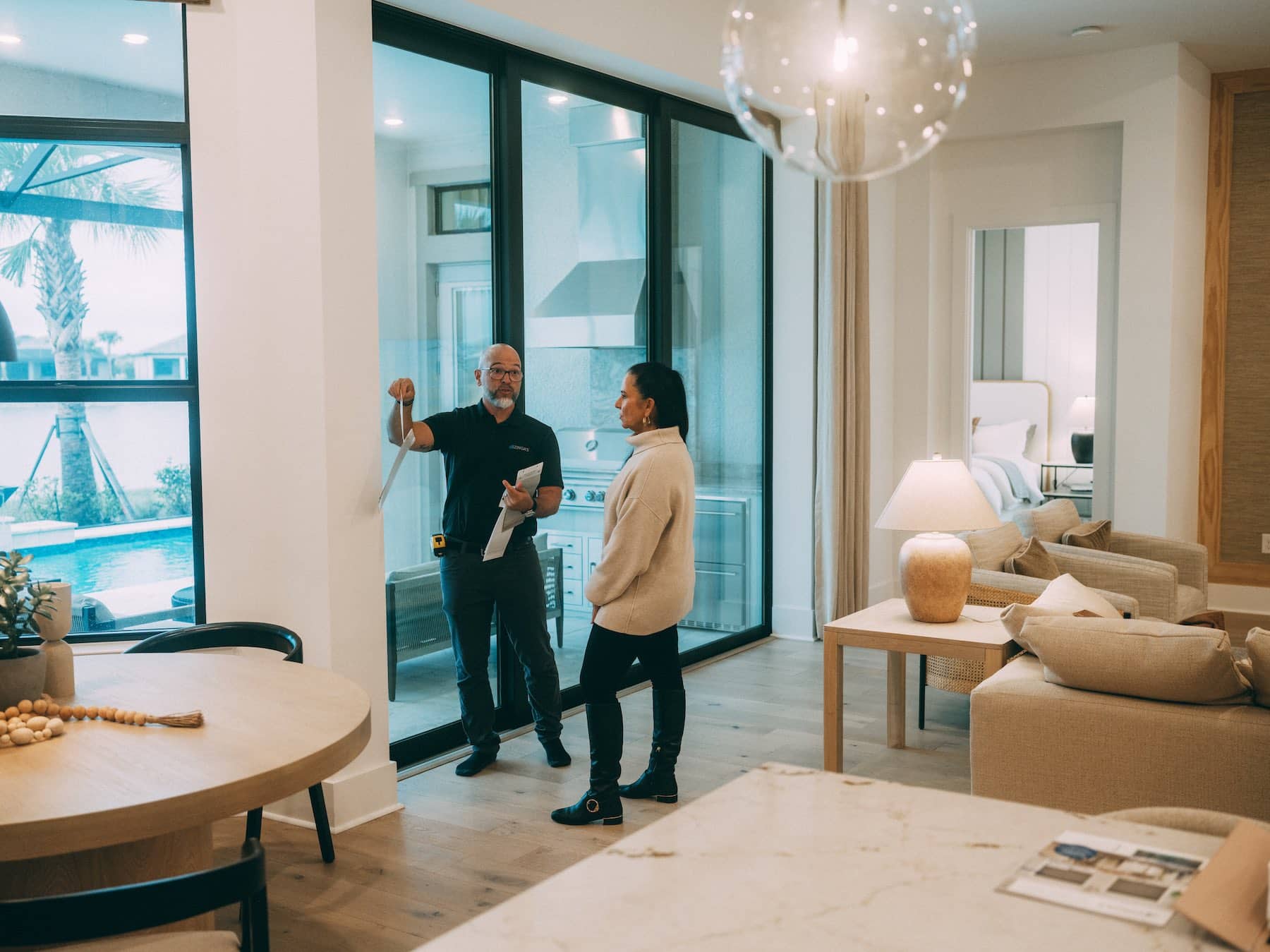
Shades Made Simple.
STEP 1: Complimentary In-Home Consultation
We bring sample products & fabrics directly to your home so you can see and feel the products in your home.
STEP 2: Precise Measuring & No Pressure Quote
We take precise measurements of all your windows and provide you a no pressure quote at the time of your consultation.
STEP 3: Hassle Free Installation
Installation completed by Zinga's employee who are experts in their craft. Free yourself of the stress of installing.
Building a Home?
Building a home can be stressful enough, let us take the burden of window treatments off your hands. We will meet with you after your drywall is complete and can install as soon as you move in!

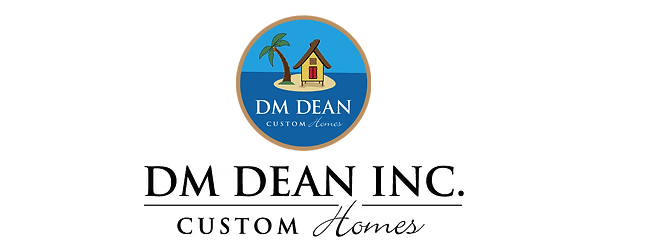


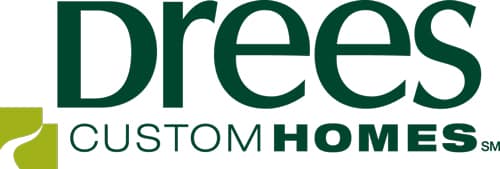


Who Is Zinga’s?
Zinga’s has been offering window treatments for 25 years and has grown 25% year over year! How did we do that? Simple, we’ve put our customer first. We genuinely love our customers and giving them great service. We want to wow our customers and when you wow your customers they give great referrals. See our over 2000+ reviews, our customers speak for themselves!
Learn More About Zinga's









